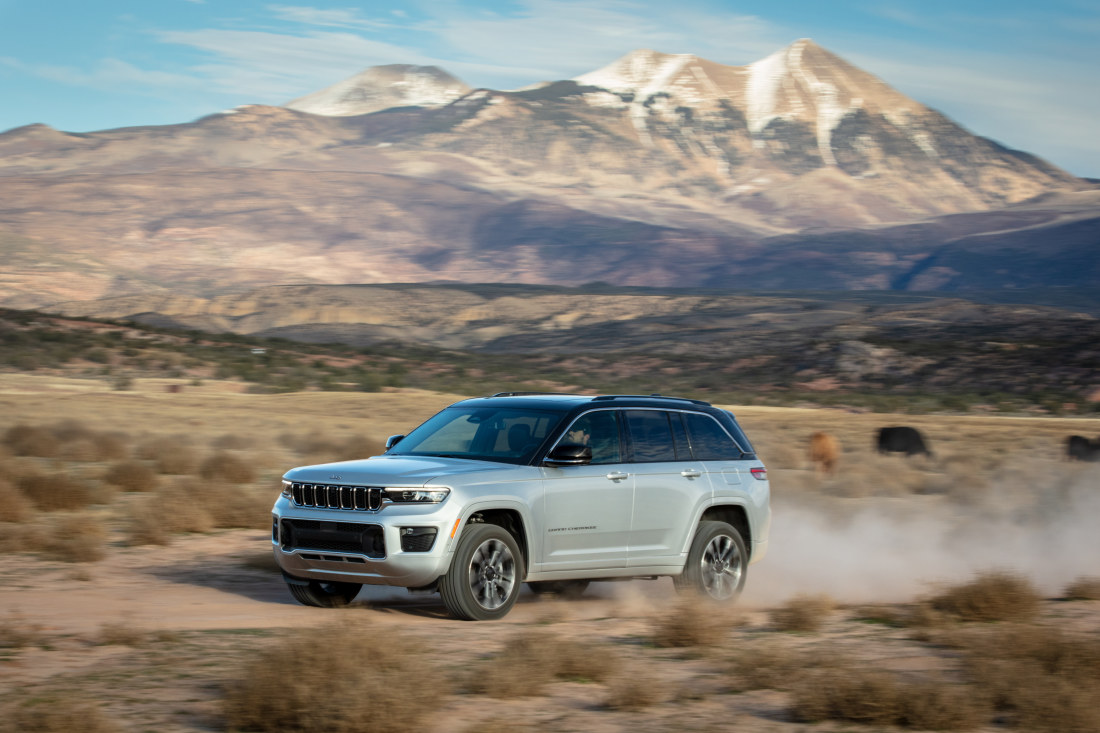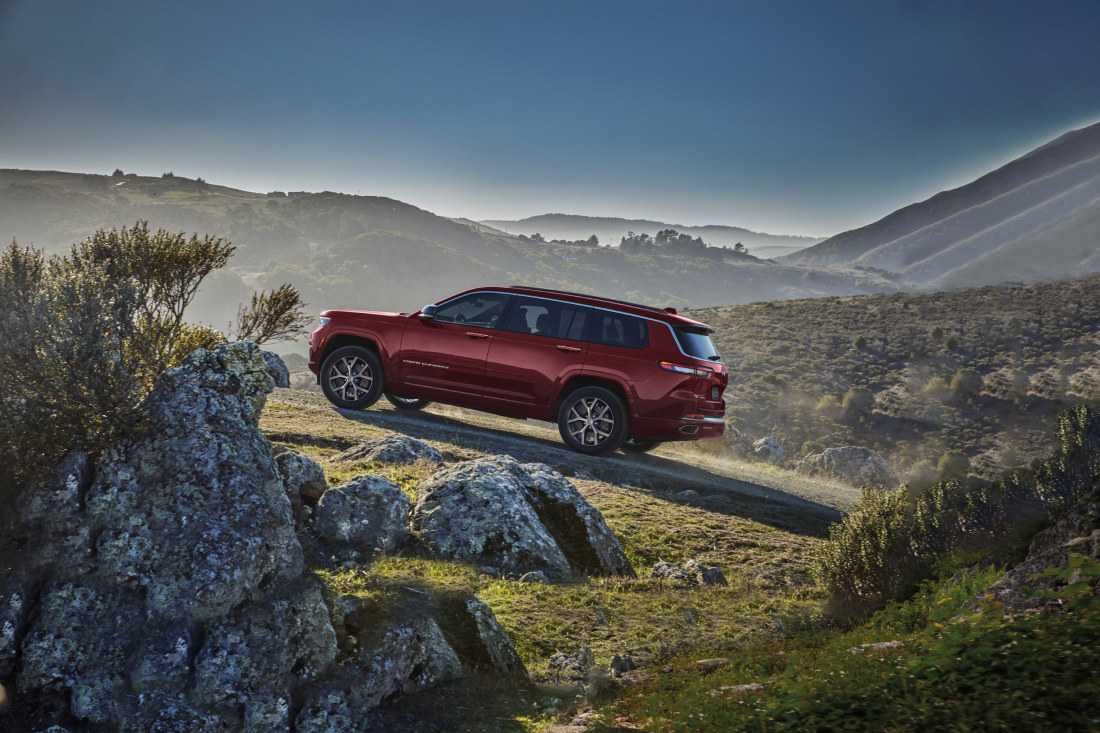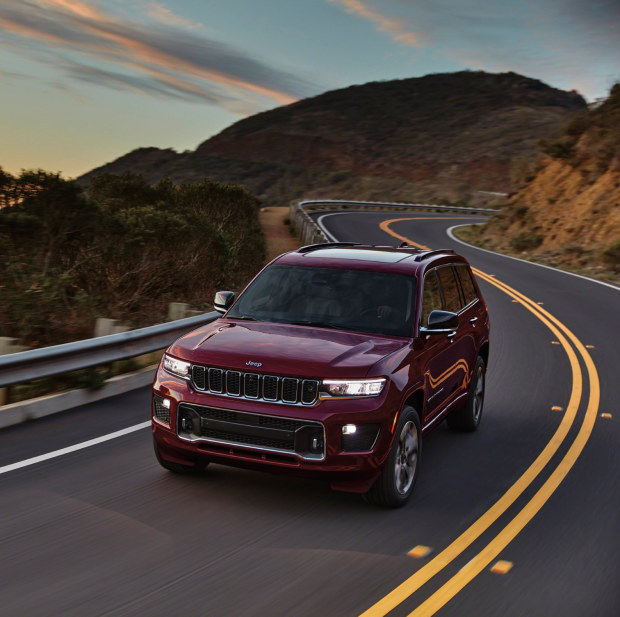Will the new Jeep Grand Cherokee Overland live up to its name?
The best-handling variant ever has a touch of the Italian about it: a decidedly on-road bias.
There is now a five-seater version of the all-new fifth-generation Jeep Grand Cherokee on sale.
Compared with the seven-seater L variant that preceded it, it’s a smaller, lighter package. It is also the best-handling Grand Cherokee ever, and you can thank the Italians for that.

The new Overland handles superbly on tar, but might not be as good off-road as its bigger predecessor.
Unlike say, the body-on-frame Toyota LandCruiser, the Grand Cherokee has a monocoque (or unibody) construction. The previous model was built on an adapted Mercedes platform, a relic of the ill-fated DaimlerChrysler days.
This one shares its foundations with current Stellantis stablemates, including the Alfa Romeo Stelvio and Maserati Grecale SUVs – two sports utility vehicles known for their excellent manners on the black stuff.
Performance is fine in normal driving, though it might be different in hilly terrain with the vehicle packed to the gunwales.
The five-seater Grand Cherokee range starts with the $78k Night Eagle, followed by the $84k Limited and the version we are testing, the Overland, at $98,450. To all these prices you must add on-road costs.
All are powered by the same 3.6-litre V6 and have permanent four-wheel drive. There’s no sign of the previous V8 or turbodiesel options on this market, but there is a new PHEV, or plug-in hybrid. With an electrically boosted 2-litre turbo petrol engine, the PHEV is known as the Summit Reserve 4xe, and is an ambitious $129,950 plus on-road costs.

Engine output is nothing special for a vehicle weighing nearly 2.2 tonnes.
The Overland badges on our car refer to superior off-road abilities. It has a low-range transfer case and height-adjustable air suspension that gives up to 276 mm of ground clearance. There are also more goodies than on lower-priced Grand Cherokees, including a dual-pane glass roof, upgraded sound and lighting, and a powered tailgate.
Two optional packs were fitted to our car, one with an emphasis on luxury, the other to further improve off-road driving (more underbody protection, an electronic limited slip diff at the rear, and 18-inch wheels rather than the road-biased 20s fitted as standard). These packs and the dark metallic Rocky Mountain exterior hue increased the price by $9000.
Even the base car cops a big price jump over the superseded model, though the maker points to more equipment and refinement across the range. There is certainly a much classier and quieter interior. Our test car had nicely done dark wood veneers on dash and doors, and perforated black leather seating with contrast stitching. The cabin was roomy, comfortable and lacked very little in terms of comfort and convenience items.
Telematics and controls have a lot in common with the Fiat 500e electric car tested recently, both using variations on the Stellantis Group architecture. These include little buttons on the back of the steering wheel that allow you to adjust sound-system volume, and to fast-forward and rewind tracks. They are handy, except when you accidentally tap the adjacent (and tiny) manual gear-shift paddles.

Classy and quiet: there is no faulting the car’s exterior and interior design.
The Jeep’s Uconnect operating system links with an app, allowing various remote functions (locking and unlocking, sending navigation instructions to the car, etc). The wireless phone mirroring works well, as does the adaptive cruise control, though the lane-keeping seemed rather random in its beeping. There are plenty of cabin storage spaces and power outlets (USB-A and C, 12-volt and even a 230-volt powerpoint) and a wireless charging pad.
The engine output is nothing special for a vehicle weighing nearly 2.2 tonnes. The max figures are 210 kW and 344 Nm and peak torque comes at a high 4000 rpm. Performance is fine in normal driving though it might be different in hilly terrain with the vehicle packed to the gunwales – or while hopping over boulders. Around town the excellent eight-speed auto kicks down quickly and seems always to know the best gear.
We didn’t test the car’s off-road abilities, this time around. Whether most owners will, is always a question; they bring the penalty of increased noise and reduced handling from those big off-road tyres, and higher fuel consumption. Cruising between cities we averaged just below 9 l/100 km, a great deal better than the V8 would have achieved, but still quite high for constant-speed highway running. Around town, the figure was into the teens.
While the handling has improved enormously over the previous model, the Italian cars cited above have very much an on-road bias. This may mean the Grand Cherokee is not as good off-road as its predecessor. What we can confirm is that the towing capacity has been reduced in the model changeover (from 3500 kg braked, to 2813 kg).
You can’t have everything.
Jeep Grand Cherokee
- Price | $98,450 (excluding on-road costs); $107,450 as tested
- Engine | 3.6-litre V6 (petrol)
- Power/torque | 210 kW/344 Nm
- Fuel economy | 9.9 L/100 km (combined cycle)
- C0₂ | 236 g/km
Read next in Motoring by Tony Davis
- Vegan v real leather: the inside story that’s dividing carmakers Almost all electric vehicles are being rolled out with sustainable, animal-friendly upholstery. But traditionalists say the industry and consumers are being greenwashed.
- Why the all-electric Fiat 500e will win your heart but not your mind It feels nippy, looks cute and is gorgeously styled, with a touch of Fellini about it. But all this charm doesn’t come cheap.
- The new $80,000 Mazda CX-60 bucks the EV trend It has the convenience of a petrol engine or a battery, depending on your needs, but most drivers now prefer a fully electric vehicle.
- Why the rear of Bentley’s Bentayga EWB is its greatest asset The new, $514K-plus model has been stretched to 5305 mm: big enough for all manner of creature comforts in the back.
- Brutalism on wheels: why the new BMW 740i has limited appeal Would you pay $268,900, plus on-road costs, for a luxurious but hefty petrol limo when that very concept seems to be outdated?
- Alfa Romeo to up its output, including an EV The brand tips a limited-edition “halo car” every few years in addition to mainstream models, and electric vehicles from 2025.
Introducing your Newsfeed
Follow the topics, people and companies that matter to you.
Find out moreRead More

Latest In Cars, bikes, boats
Fetching latest articles